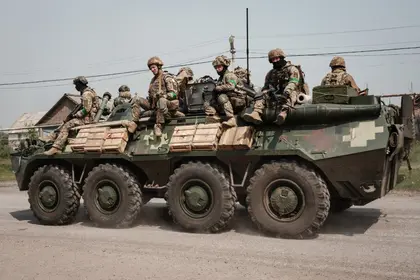Ukrainian southern “offensive” possibly gaining steam, observers claim Kherson liberation is UAF objective.
Ukrainian limited counterattacks in the southern Kherson-Mykolaiv sector appear to be gaining ground, and if the Kyiv advance keeps on rolling Russian military supply lines to Crimea could be endangered and Kherson liberated, military observers said on Thursday.
JOIN US ON TELEGRAM
Follow our coverage of the war on the @Kyivpost_official.
Military analyst Oleh Zhdanov in June 2 comments widely repeated by Ukrainian news platforms said Ukraine Armed Forces (UAF) units operating along the right bank of the Dnipro River had achieved a limited break through past RF defensive positions near the town Snegurivka, and were advancing towards the RF-occupied town Nova Kakhkovka, on the Dnipro River.
Nova Kakhovka contains one of the few bridges over the Dnipro, a major waterway and barrier to military ground operations. Were UAF forces to cross the Nova Kakhovka bridge and establish a bridgehead on the Dnipro’s south bank, they would be positioned to cut RF military supply lines to Crimea and liberate the city Kherson, Zhdanov said.
In June 1 televised comments, Konstantyn Mashovets, coordinator of the UAF volunteer support group Information Resistance, likewise said that newly-reinforced UAF formations have launched successful local attacks, and that new deliveries of men and weapons will make possible a major UAF offensive in the southern sector in coming weeks. The objective of the offensive will be to liberate the city Kherson, occupied since the second week of the war, and cut supply lines to all RF forces north of the city, he said.
Ukrainian military-based social media video showed images of Bayraktar strike drones destroying RF armored vehicles, and Grad rocket artillery launchers launching salvoes, both purportedly in the southern sector. Vitaly Kim, head of the Mykolaiv regional defense command, in a June 2 statement said that UAF forces were increasing pressure in the southern sector, and that their ultimate objective was Kherson, but gave no details. He repeated a call, made repeatedly since March, that Kherson residents should not give up hope and that UAF liberation is coming in the “near future”.
A Thursday analysis by the Institute for the Study of War (ISW) said an ongoing UAF offensive in the south had progressed to the point that, unless halted, RF supply lines to Kremlin forces in Kherson region would be threatened.
A June 1 statement by the RF-controlled Kherson regional government stated that supplies to the region were absolutely reliable, that RF army logistics are strong, resilient and no longer dependent on deliveries from RF-controlled Crimea. “This will be the situation forever”, the statement said in part.
The pro-Russia Readovka news platform in a June 2 morning situation claimed UAF units suffered a disastrous defeat around Snegurivka and were forced to retreat, and that RF S-300 anti-aircraft missiles shot down at least one Bayraktar strike drone in the vicinity of the UAF-controlled town of Voznesensk. The information agency shortly after midday published an update, reporting that UAF forces in battalion strength – a force level distinctly bigger than past UAF operations in the southern sector – were attacking the village with armor and artillery. RF units in the vicinity were under heavy pressure but fighting back, the report said.
Ukraine’s Army General Staff (AGS) on June 2 claimed UAF forces won a rare naval victory, sinking two RF fast assault boats operating in the mouth of the Southern Bug River, off the port of Ochakov. The AGS statement reported engagements at multiple locations along the southern front and claimed more than 20 RF military vehicles destroyed. RF state-controlled media made no reference to the alleged naval engagement.
Officers serving with two Mechanized Infantry brigades in the Mykolaiv sector told a Kyiv Post reporter in over-the-weekend interviews that limited attacks in the southern were proceeding and had obtained some local success, but, that UAF forces lack the firepower – particularly in massed artillery – to support a major bridging operation across the Dnipro. Western guns have arrived in sector but so far NATO heavy weapons are too limited in numbers to influence the situation across the southern front, they said.
You can also highlight the text and press Ctrl + Enter



